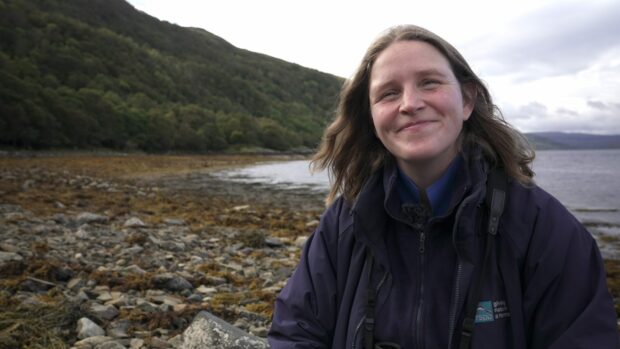Few people wake to the sound of their own rainforest, but it’s an everyday blessing for Highland wildlife lover Izzy Baker.
The 32-year-old RSPB nature reserve warden lives, sleeps and breathes in a woodland on the west coast of Scotland so festooned with lichen, moss and ferns it’s classified as temperate rainforest.
Izzy is responsible for a pair of important nature reserves on the Morvern peninsula, north-west of Oban containing some of the country’s best examples of the precious and rare habitat.
But she hasn’t just taken the health of the forests under her wing — at her small croft on the peninsula she cares for 20 sheep and five cows.
Izzy says her experience “of actually being immersed in rainforest, actually living in one” has handed her a solid appreciation of the magic that goes on all around her.
What is it that makes a Scottish woodland a Scottish rainforest?
“There’s stuff growing off every tree and all across the forest floor,” says Izzy.
“It’s all up the trees, it covers every surface. There isn’t a single tree here that’s just a tree.”
So, what is it that makes the forests of the Morvern peninsula so special that it’s called a rainforest?
Essentially, a combination of heavy rain, wet warm winters and a temperature lacking in variation has created the perfect conditions for one of the world’s most biologically-diverse ecosystems — right here, on Scotland’s west coast.
The temperate rainforest habitat also grows fragmentedly on other parts of the west coast, plus on a handful of other corners of the planet, including Ireland and Canada.
But it is thought to be even rarer than its tropical counterpart.
Izzy manages two reserves with rainforest habitat, namely the 100-hectare Glenborrodale nature reserve and the 64-hectare Glencripesdale reserve, both of which are owned by the RSPB.
She says her life spending her days working in the Scottish rainforests, which are home to hundreds of different species of plant and all kinds of animals, is “just amazing”.
Izzy shares her seasons in the Scottish rainforest with all sorts of animals
“They are places that change a lot during the year,” said Izzy.
“In the spring it’s really loud, there’s all sorts of different birds calling, quite often you don’t get to see them because they’re in the canopy, but you can hear them.
“In the summer, we have migrants from Africa which breed in the woodland, like wood warbler and tree pipits.
“And then when you get to this time of year it’s very quiet and you get winter flocks that zoom through, like long-tailed tits, red wings, fieldfair, and then it goes really quiet again.”
Izzy said otters, pine martens, badgers, red squirrel, and deer are also commonly seen, as well as some rare insects.
She added: “There’s some really rare butterflies that enjoy these woodlands like the chequered skipper which is a really important one for here.
“It only occurs within about a 30-mile radius of Fort William in Britain, although it has just been reintroduced in England.”
How did Izzy get her job looking after the rainforest?
Izzy said her role as a warden living and working in the Scottish rainforests on the west coast is her dream job.
The 32-year-old managed to secure it thanks to a lot of dedication to volunteering work.
She took on a nine-month placement volunteering on the island of Oronsay, north of Islay, where she did all kinds of agricultural work on an agricultural reserve.
This eventually led to her getting her foot in the door to work with the RSPB at the Morvern peninsula’s rainforests.
She added: “It turned out to be a really valuable thing to do.”
The threats to the Scottish rainforest, and what Izzy and the RSPB are doing to address them
Izzy’s work involves enhancing and restoring important areas of the rainforest on the peninsula, which are under threat from non-native plants — mainly rhododendron —and browsing deer, which damage the trees.
Seeing the differences first-hand that protective measures make against these threats to the Scottish rainforest is what keeps Izzy motivated.
She said: “The big threat to this habitat is non-native species.
“We had a project to clear all of the rhododendron from across the Glenborrodale reserve.
“To see that happen after two years of organising and talking about it, seeing it happen on the ground, it just felt like such a really good achievement.
“You can see a complete difference on the ground.”
A funding campaign has been set up to help pay for the protection work for at the Morvern peninsula, and conservationists are appealing to the Scottish Government for bigger-picture funding of £250-£500 million to restore and regrow the habitat across the whole of the country.
You can find out more about this funding campaign, and how you can help, here.










Conversation